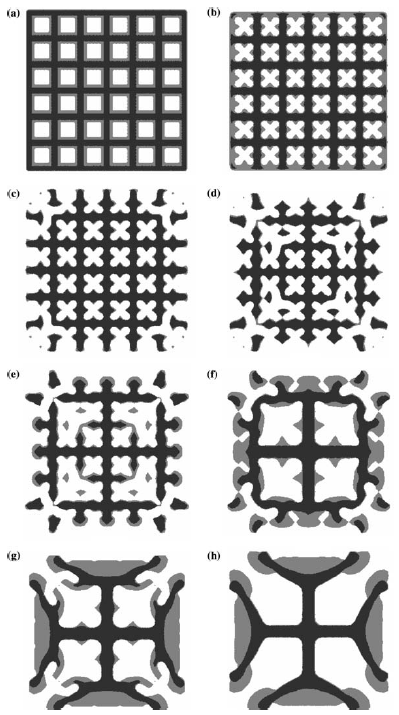Our sites
eServices
- Grenoble Savoie Directory
- Reserved Services
- Intranet Grenoble INP
 Connexion
Connexion
 Connexion
Connexion

Project description and objectives : Traditionally, materials design involves the ability to predict and tailor the properties and responses of a material for a given engineering application while controlling chemistry and processing history. Over the past few decades, materials design has expanded to take advantage of advanced optimization algorithms and methods [7]. In this approach, “spatial heterogeneity” is controlled such that combinations of materials or of material and space are arranged in configurations and with connectivities that offer enhanced performance [2-6]. Often the demands of anti-correlated property combinations (for example, high stiffness (Young’s modulus) and low expansion (coefficient of thermal expansion)) require the use of optimization tools to identify structures that may no longer be intuitive and involve complex shape [2-6].
Scope of the work
A collaboration between SIMAP and LJK (Grenoble, France), CMAP (Ecole Polytechnique, Palaiseau, France), and Lehigh University (Pennsylvania, USA) has been established in order to address the interdisciplinary problem of materials-based topology optimization. The team (R. Estevez, G. Parry, N. Vermaak, Y. Brechet, G. Michailidis, G. Allaire) has established level set-based optimization protocols that have already led to a joint publication [1]. However, improvements and augmentations of their algorithms and scope are needed in order to make a significant impact in the area of linear and nonlinear cellular materials design. The established codes are restricted to calculations in 2D and are written in the open source numerical computation software SCILAB, which prohibits for the moment, direct extension to 3D due to computational inefficiencies. The primary goals of the proposed work will then be to:
(i) Investigate interface effects in 2D benchmark problems of materials design. Optimize both the topology and materials interface profile for a prescribed set of 2D and 3D materials design problems that have been previously studied (without interface effects) in the literature. An example of a typical benchmark problem in materials design is given in Figure 1 [8]. The objective is to construct a microstructure with the specified homogenized elastic tensor, E*1111=E*2222=0.05 (GPa), and thermal stress tensor, a*11=a*22=0.1 (kPa/ C), under the volume ratio of 0.2 for the first phase (black) and of 0.24 for the second phase (grey, see Figure 1). The shear stiffness of the microstructure is constrained by E*1212 ³ 0.05 (GPa) in order to ensure sufficient rigidity. This item investigates the influence of interface characteristics on improving the derivation of effective target properties of a heterogeneous representative (periodic) volume element. The proposed work for this task is an extension of the work performed with homogenization methods in which interfaces properties were ignored. Accounting for non-homogeneous interfaces between bulk materials can result in design improvements and opens new routes in manufacturing and processing for materials microstructures.
(ii) Extension to geometrically non-linear problems or problems with nonlinear material response. Optimization of materials design problems beyond benchmark cases will also be considered. These problems will incorporate more realistic boundary and loading conditions including: anisotropic bulk material properties, non-homogeneous thermal fields, distributed loads, and geometric and material non-linearity. Towards this goal, the selection and justification of appropriate optimization algorithms will also be addressed. In all cases, the influence of the interface zone thickness on the optimization will be explored.
(iii) Fabrication & Processing. Additive manufacturing presents an ideal technique for creating graded or diffuse interfaces in both polymeric and metallic systems. Both institutions involved in this project offer unique equipment and facilities to provide prototype realizations of topologically optimized systems. As mentioned above, it is our view that along with the advance of optimization tools, simultaneously, cooperative feedback with emerging processing and manufacturing methods is required to ensure integrated design optimization. Below, a few relevant complementary techniques available through the proposed partnership are described.
The project will also benefit from a close collaboration with the applied mathematics community: G Allaire at CMAP (Ecole Polytechnique, Paris) and F Jouve (Université Paris Diderot) and locally with E Bonnetier of laboratory LJK at Grenoble. The motivation is to pursue a fruitful long-term collaboration of this team initiated during N. Vermaak ‘s post-doc at SIMaP during 2012-2013.

FIGURE 1: Optimal microstructure with low thermal expansion coefficients with a minimum shear stiffness and target material volume fractions specified. (a-g) show intermediate designs and (h) shows the final optimized design [10].
REFERENCES
-> in the word documentApplication: candidates with a background in applied mathematics or mechanical engineering or materials science or applied physics are encouraged to apply. Candidates interested in experimental aspects should refrain. The topic is essentially numerical with some experimental aspects
Send resume and references to
Rafael.Estevez@simap.grenoble-inp.fr / ++33 ( 04 76 82 67 02
Directors : Rafael ESTEVEZ, G Parry (from Laboratory SIMAP at Grenoble) Natasha VERMAAK (Depart Mech Engng, Lehigh University, USA)
Duration: 36 months , starting in October 2014.
Location: University of Grenoble and Lehigh University
mise à jour le 18 juin 2014


